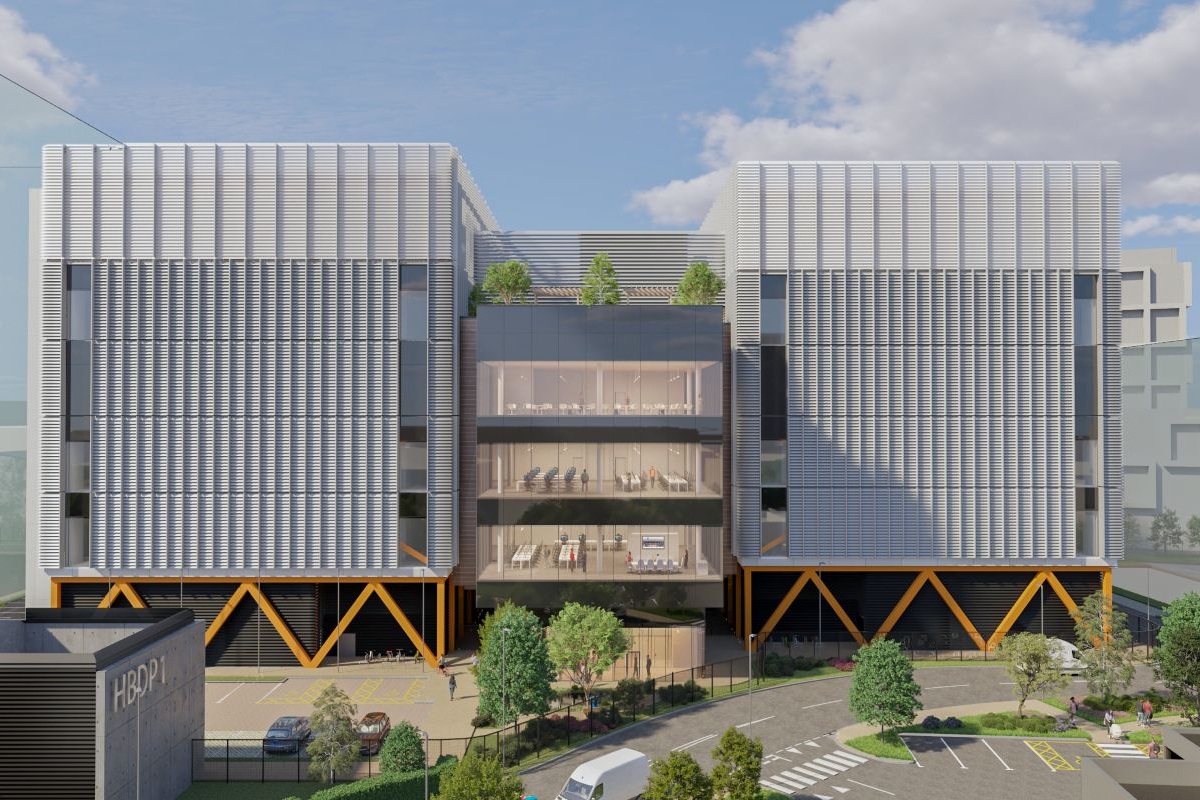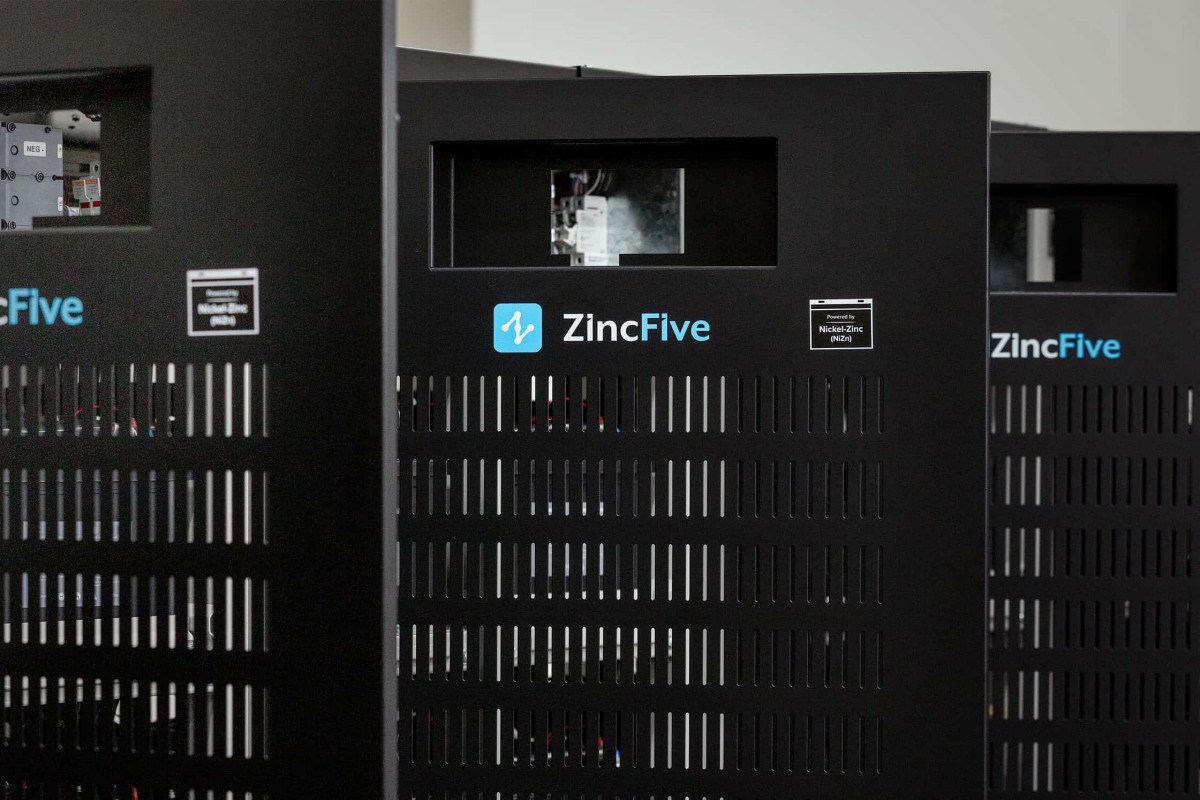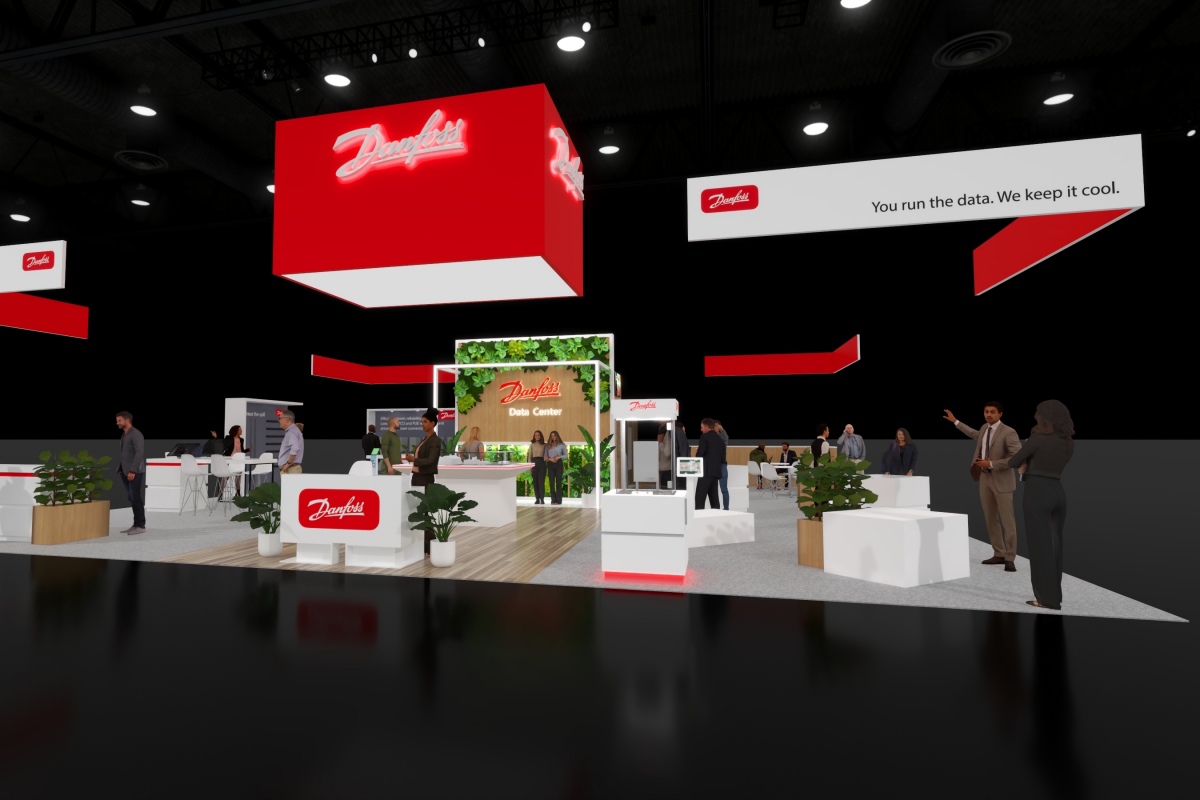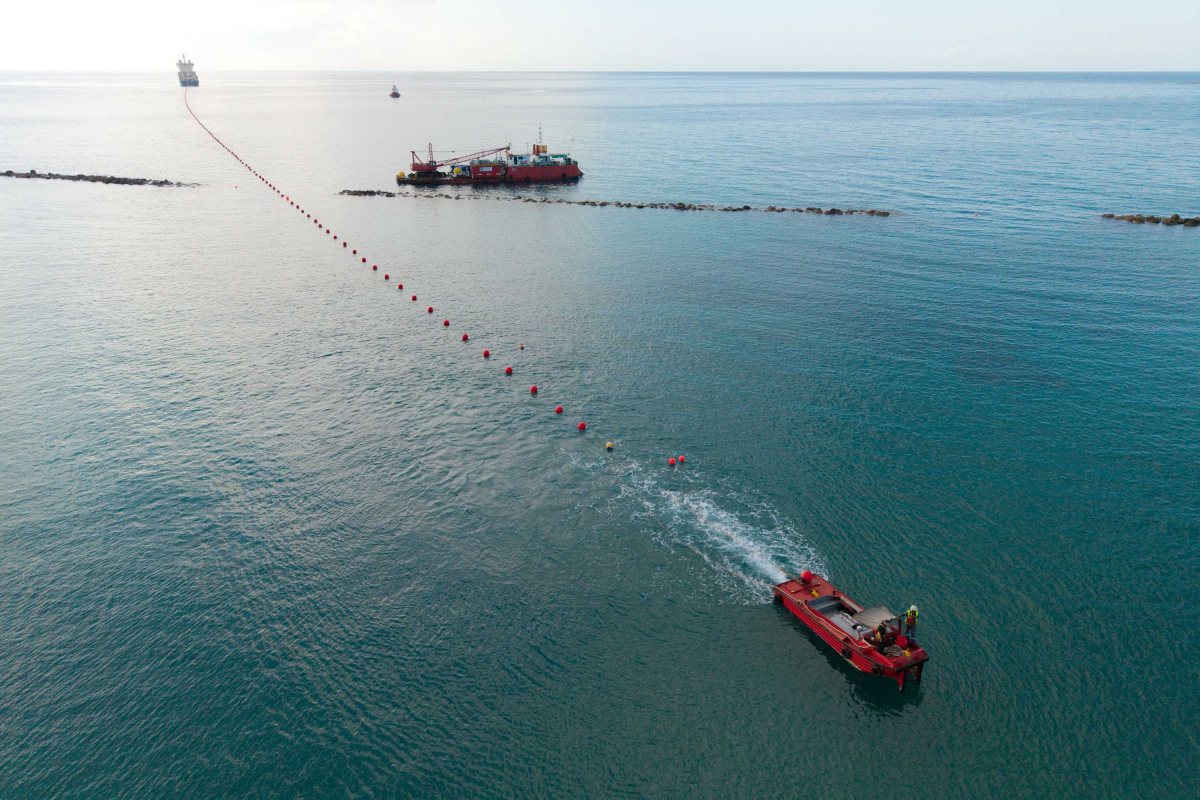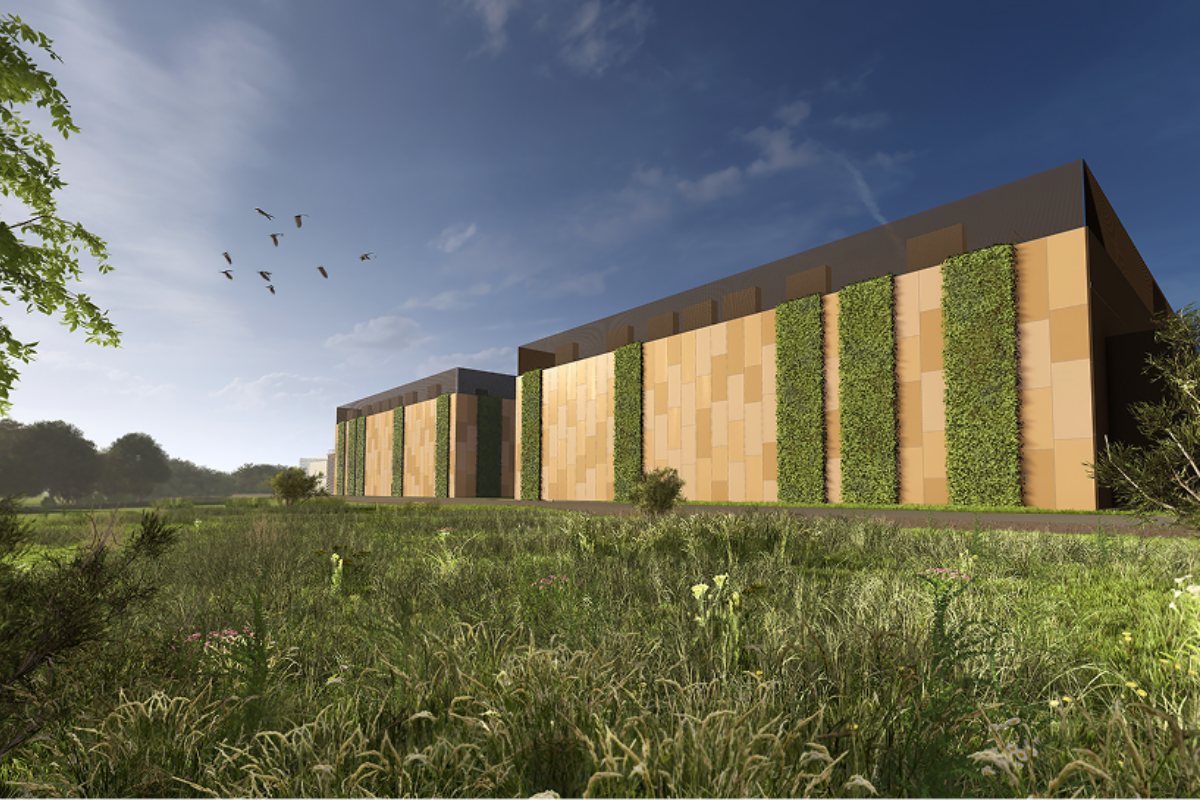7 November 2025
Oxford technology supplied to quantum-AI data centre
Oxford technology supplied to quantum-AI data centre
7 November 2025
Mission Critical Group acquires Leman Engineering
Mission Critical Group acquires Leman Engineering
7 November 2025
Vertiv expands immersion liquid cooling portfolio
Vertiv expands immersion liquid cooling portfolio
6 November 2025
Zoom to open new UK data centre
Zoom to open new UK data centre
6 November 2025
HUMAIN, AirTrunk to build DCs in Saudi Arabia
HUMAIN, AirTrunk to build DCs in Saudi Arabia
Latest News
Data Centre Build News & Insights
Data Centre Projects: Infrastructure Builds, Innovations & Updates
Data Centres
News
Colt DCS to expand West London hyperscale campus
Colt Data Centre Services (Colt DCS), a global provider of AI, hyperscale, and large enterprise data centres, has announced that it has received committee approval (Resolution to Grant) from Hillingdon Council to expand its Hayes Digital Park campus in West London with three new hyperscale data centres and an Innovation Hub.
The £2.5 billion investment will strengthen the UK’s digital infrastructure, support the government’s modern industrial strategy, and help drive the nation’s growing AI economy.
The three new hyperscale data centres - London 6, 7, and 8 - will be powered using 100% renewable energy through a Power Purchase Agreement (PPA). Power contracts for this development have been secured with National Grid and a high voltage supply is due to be delivered by October 2027. The expansion will add an additional 97MW to the available IT power at the Hayes Digital Park, taking the total capacity to 160MW. Construction is expected to start in mid-2026, with the first data centre (London 6) scheduled to go live in early 2029. Once operational, the new facilities will create over 500 permanent jobs, training more than 50 technical apprentices over a 10-year build programme.
In addition to the data centres, Colt DCS will develop an Innovation Hub in partnership with Brunel University, designed to serve as a community space and incubator for digital start-ups. The hub will promote economic synergy by co-locating light-industrial and digital innovation businesses, creating opportunities for collaboration, research, and skills development within an affordable workspace. Students from Brunel University will be encouraged to use the hub to develop entrepreneurial projects and technology-led ventures to support the digital economy.
AECOM has been appointed to develop the design proposals for the Innovation Hub. The facility aims to act as a base for innovation and community engagement, with flexible space for future industrial use, in line with planning policy for Strategic Industrial Land. It will also provide social value by hosting local events themed around culture, food, film, music, and literature.
The new development will also deliver a district heating network, using waste heat from the data centres to support local businesses, communities, and residential buildings. Under the planning permission, back-up generators will only be permitted to operate for a maximum of 15 hours per year, with the data centres powered directly from the national grid.
“This announcement marks another important milestone for the UK’s digital economy,” says Xavier Matagne, Chief Real Estate Officer at Colt DCS. “Data centres are a cornerstone of digital transformation. With this expansion, we can help power innovation, support the AI revolution, and contribute to the energy transition.”
Xavier continues, “Our new campus in Hayes, including the Innovation Hub in partnership with Brunel University, will drive community value, from reusing heat for district heating to creating jobs, skills, and long-term investment. As one of the few operators capable of delivering new capacity in this area of London over the next decade, we’re proud to be helping power the UK’s future economy in a sustainable and inclusive way.”
Cllr Steve Tuckwell, Hillingdon Council's Cabinet Member for Planning, Housing and Growth, notes, "Hillingdon is open for business, and we're working closely with our business community, new and existing investors and partners to drive innovation and development in the right places.
"The innovation hub is an exciting new development that will help to foster economic growth. It will help to equip residents and smaller local businesses with the right skills, affordable workspaces, and opportunities to thrive.
"Hayes is playing a leading role in shaping London's digital economy and infrastructure and it's vital local people have more opportunities to experience the benefits."
For more from Colt DCS, click here.
Simon Rowley - 5 November 2025
Artificial Intelligence in Data Centre Operations
Data Centre Architecture Insights & Best Practices
Data Centre Build News & Insights
Data Centre Operations: Optimising Infrastructure for Performance and Reliability
America’s AI revolution needs the right infrastructure
In this article, Ivo Ivanov, CEO of DE-CIX, argues his case for why America’s AI revolution won’t happen without the right kind of infrastructure:
Boom or bust
Artificial intelligence might well be the defining technology of our time, but its future rests on something much less tangible hiding beneath the surface: latency.
Every AI service, whether training models across distributed GPU-as-a-Service communities or running inference close to end users, depends on how fast, how securely, and how cost-effectively data can move.
Network latency is simply the delay in the speed of traffic transmission caused by the distance the data needs to travel: the lower latency is (i.e. the faster the transmission), the better the performance of everything from autonomous vehicles to the applications we carry in our pockets.
There’s always been a trend of technology applications outpacing network capabilities, but we’re feeling it more acutely now due to the sheer pace of AI growth. Depending on where you were in 2012, the average latency for the top 20 applications could be up to or more than 200 milliseconds. Today, there’s virtually no application in the top 100 that would function effectively with that kind of latency. That’s why internet exchanges (IXs) have begun to dominate the conversation.
An IX is like an airport for data. Just as an airport coordinates the safe landing and departure of dozens of airlines, allowing them to exchange passengers and cargo seamlessly, an IX brings together networks, clouds, and content platforms to seamlessly exchange traffic. The result is faster connections, lower latency, greater efficiency, and a smoother journey for every digital service that depends on it.
Deploying these IXs creates what is known as “data gravity”, a magnetic pull that draws in networks, content, and investment. Once this gravity takes hold, ecosystems begin to grow on their own, localising data and services, reducing latency, and fuelling economic growth.
I recently spoke about this at a first-of-its-kind regional AI connectivity summit, The future of AI connectivity in Kansas & beyond, hosted at the Wichita State University (WSU) in Kansas, USA. It was the perfect location - given that WSU is the planned site of a new carrier-neutral IX - and the start of a much bigger plan to roll out IXs across university campuses nationwide. Discussions at the summit reflected a growing recognition that America’s AI economy cannot depend solely on coastal hubs or isolated mega-data centres. If AI is to deliver value across all parts of the economy, from aerospace and healthcare to finance and education, it needs a distributed, resilient, and secure interconnection layer reaching deep into the heartland. What is beginning in Wichita is part of a much bigger picture: building the kind of digital infrastructure that will allow AI to flourish.
Networking changed the game, but AI is changing the rules
For all its potential, AI’s crowning achievement so far might be the wakeup call it’s given us. It has magnified every weakness in today’s networks.
Training up models requires immense compute power. Finding the data centre space for this can be a challenge, but new data transport protocols are meaning that AI processing could, in the future, be spread across multiple data centre facilities. Meanwhile, inference - and especially multi-AI agentive inference - demands ultra-low latency, as AI services interact with systems, people, and businesses in real time. But for both of these scenarios, the efficiency and speed of the network is key. If the network cannot keep pace (if data needs to travel too far), these applications become too slow to be useful. That’s why the next breakthrough in AI won’t be in bigger or better models, but in the infrastructure that connects them all. By bringing networks, clouds, and enterprises together on a neutral platform, an IX makes it possible to aggregate GPU resources across locations, create agile GPU-as-a-Service communities, and deliver real-time inference with the best performance and highest level of security.
AI changes the geography of networking too. Instead of relying only on mega-hubs in key locations, we need interconnection spokes that reach into every region where people live, work, and innovate. Otherwise, businesses in the middle of the country face the “tromboning effect”, where their data detours hundreds of miles to another city to be exchanged and processed before returning a result - adding latency, raising costs, and weakening performance. We need to make these distances shorter, reduce path complexity, and allow data to move freely and securely between every player in the network chain. That’s how AI is rewriting the rulebook; latency, underpinned by distance and geography, matters more than ever.
Building ecosystems and 'data gravity'
When we establish an IX, we’re doing more than just connecting networks; we’re forging the embers of a future-proof ecosystem. I’ve seen this happen countless times. The moment a neutral (meaning data centre and carrier neutral) exchange is in place, it becomes a magnet that draws in networks, content providers, data centres, and investors. The pull of “data gravity” transforms a market from being dependent on distant hubs into a self-sustaining digital environment. What may look like a small step - a handful of networks exchanging traffic locally - very quickly becomes an accelerant for rapid growth.
Dubai is one of the clearest examples. When we opened our first international platform there in 2012, 90% of the content used in the region was hosted outside of the Middle East, with latency above 200 milliseconds. A decade later, 90% of that content is localised within the region and latency has dropped to just three milliseconds. This was a direct result of the gravity created by the exchange, pulling more and more stakeholders into the ecosystem. For AI, that localisation isn’t just beneficial; it’s also essential. Training and inference both depend on data being closer to where it is needed. Without the gravity of an IX, content and compute remain scattered and far away, and performance suffers. With it, however, entire regions can unlock the kind of digital transformation that AI demands.
The American challenge
There was a time when connectivity infrastructure was dominated by a handful of incumbents, but that time has long since passed. Building AI-ready infrastructure isn’t something that one organisation or sector can do alone. Everywhere that has succeeded in building an AI-ready network environment has done so through partnerships - between data centre, network, and IX operators, alongside policy makers, technology providers, universities, and - of course - the business community itself. When those pieces of the puzzle are assembled together, the result is a healthy ecosystem that benefits everyone.
This collaborative model, like the one envisaged at the IX in WSU, is exactly what the US needs if it is to realise the full potential of AI. Too much of America’s digital economy still depends on coastal hubs, while the centre of the country is underserved. That means businesses in aerospace, healthcare, finance, and education - many of which are based deep in the US heartland - must rely on services delivered from other states and regions, and that isn’t sustainable when it comes to AI. To solve this, we need a distributed layer of interconnection that extends across the entire nation. Only then can we create a truly digital America where every city has access to the same secure, high-performance infrastructure required to power its AI-driven future.
For more from DE-CIX, click here.
Joe Peck - 5 November 2025
Data Centre Infrastructure News & Trends
Exclusive
Innovations in Data Center Power and Cooling Solutions
Liquid Cooling Technologies Driving Data Centre Efficiency
CDUs: The brains of direct liquid cooling
As air cooling reaches its limits with AI and HPC workloads exceeding 100 kW per rack, hybrid liquid cooling is becoming essential. To this, coolant distribution units (CDUs) could be the key enabler for next-generation, high-density data centre facilities.
In this article for DCNN, Gordon Johnson, Senior CFD Manager at Subzero Engineering, discusses further the importance of CDUs in direct liquid cooling:
Cooling and the future of data centres
Traditional air cooling has hit its limits, with rack power densities surpassing 100 kW due to the relentless growth of AI and high-performance computing (HPC) workloads. Already, CPUs and GPUs exceed 700–1000 W per socket, while projections estimate that to rise to over 1500 W going forward.
Fans and heat sinks are just unable to handle these thermal loads at scale. Hybrid cooling strategies are becoming the only scalable, sustainable path forward.
Single-phase direct-to-chip (DTC) liquid cooling has emerged as the most practical and serviceable solution, delivering coolant directly to cold plates attached to processors and accelerators. However, direct liquid cooling (DLC) cannot be scaled safely or efficiently with plumbing alone. The key enabler is the coolant distribution unit (CDU), a system that integrates pumps, heat exchangers, sensors, and control logic into a coordinated package.
CDUs are often mistaken for passive infrastructure. But far from being a passive subsystem, they act as the brains of DLC, orchestrating isolation, stability, adaptability, and efficiency to make DTC viable at data centre scale. They serve as the intelligent control layer for the entire thermal management system.
Intelligent orchestration
CDUs do a lot more than just transport fluid around the cooling system; they think, adapt, and protect the liquid cooling portion of the hybrid cooling system. They maintain redundancy to ensure continuous operation, control flow, and pressure, using automated valves and variable speed pumps, filtering particulates to protect cold plates, and maintaining coolant temperature above the dew point to prevent condensation. They contribute to the precise, intelligent, and flexible coordination of the complete thermal management system.
Because of their greater cooling capacity, CDUs are ideal for large HPC data centres. However, because they must be connected to the facility's chilled water supply or another heat rejection source to continuously provide liquid to the cold plates for cooling, they can be complicated.
CDUs typically fall into two categories:
• Liquid to Liquid (L2L): Large HPC facilities are well-suited for high-capacity CDUs known as L2L. Through heat exchangers, they move chip heat into the isolated chilled water loop, such as the facility water system (FWS).
• Liquid to Air (L2A): For smaller deployments, L2A CDUs are simpler but have a lower cooling capacity. By utilising conventional HVAC systems, they transfer heat from the returning liquid coolant from the cold plates to the surrounding data centre air by using liquid-to-air heat exchangers rather than a chilled water supply or FWS.
Isolation: Safeguarding IT from facility water
Acting as the bridge between the FWS and the dedicated technology cooling system (TCS), which provides filtered liquid coolant directly to the chips via cold plate, CDUs isolate sensitive server cold plates from external variability, ensuring a safe and stable environment while constantly adjusting to shifting workloads.
One of L2L CDUs' primary functions is to create a dual-loop architecture:
• Primary loop (facility side): Connects to building chilled water, district cooling, or dry coolers
• Secondary loop (IT side): Delivers conditioned coolant directly to IT racks
CDUs isolate the primary loop (which may carry contaminants, particulates, scaling agents, or chemical treatments like biocides and corrosion inhibitors - chemistry that is incompatible with IT gear) from the secondary loop. As well as preventing corrosion and fouling, this isolation offers operators the safety margin that operators need for board-level confidence in liquid.
The integrity of the server cold plates is safeguarded by the CDU, which uses a heat exchanger to separate the two environments and maintain a clean, controlled fluid in the IT loop. Because CDUs are fitted with variable speed pumps, automated valves, and sensors, they can dynamically adjust the flow rate and pressure of the TCS to ensure optimal cooling even when HPC workloads change.
Stability: Balancing thermal predictability with unpredictable loads
HPC and AI workloads are not only high power; they are also volatile. GPU-intensive training jobs or changeable CPU workloads can cause high-frequency power swings, which - without regulation - would translate into thermal instability. The CDU mitigates this risk by controlling temperature, pressure, and flow across all racks and nodes, absorbing dynamic changes and delivering predictable thermal conditions.
The CDU absorbs fluctuations by stabilising temperature, pressure, and flow across all racks and nodes, regardless of how erratic the workload is. Sensor arrays ensure the cooling loop remains in accordance with specifications, while variable speed pumps modify flow to fit demand and heat exchangers are calibrated to maintain an established approach temperature.
Adaptability: Bridging facility constraints with IT requirements
The thermal architecture of data centres varies widely, with some using warm-water loops that operate at temperatures between 20 and 40°C. By adjusting secondary loop conditions to align IT requirements with the facility, the CDU adjusts to these fluctuations. The CDU uses mixing or bypass control to temper supply water. It can alternate between tower-assisted cooling, free cooling, or dry cooler rejection depending on the environmental conditions, and it can adjust flow distribution amongst racks to align with real-time demand.
This adaptability makes DTC deployable in a variety of infrastructures without requiring extensive facility renovations. It also makes it possible for liquid cooling to be phased in gradually - ideal for operators who need to make incremental upgrades.
Efficiency: Enabling sustainable scale
Beyond risk and reliability, CDUs unlock possibilities that make liquid cooling a sustainable option.
By managing flow and temperature, CDUs eliminate the inefficiencies of over-pumping and over-cooling. They also maximise scope for free cooling and heat recovery integration such as connecting to district heating networks and reclaiming waste heat as a revenue stream or sustainability benefit. This allows operators to simultaneously lower PUE (Power Usage Effectiveness) to values below 1.1 while simultaneously reducing WUE (Water Usage Effectiveness) by minimising evaporative cooling. All this, while meeting the extreme thermal demands of AI and HPC workloads.
CDUs as the thermal control plane
Viewed holistically, CDUs are far more than pumps and pipes; they are the thermal control plane for thermal management, orchestrating safe isolation, dynamic stability, infrastructure adaptability, and operational efficiency.
They translate unpredictable IT loads into manageable facility-side conditions, ensuring that single-phase DTC can be deployed at scale, enabling HPC and AI data centres to evolve into multi-hundred kilowatt racks without thermal failure.
Without CDUs, direct-to-chip cooling would be risky, uncoordinated, and inefficient. With CDUs, it becomes an intelligent and resilient architecture capable of supporting 100 kW (and higher) racks as well as the escalating thermal demands of AI and HPC clusters.
As workloads continue to climb and rack power densities surge, the industry’s ability to scale hinges on this intelligence. CDUs are not a supporting component; they are the enabler of single-phase DTC at scale and a cornerstone of the future data centre.
For more from Subzero Engineering, click here.
Joe Peck - 4 November 2025
Data Centre Infrastructure News & Trends
Innovations in Data Center Power and Cooling Solutions
News
Products
ZincFive introduces battery system designed for AI DCs
ZincFive, a producer of nickel-zinc (NiZn) battery-based solutions for immediate power applications, has announced a new nickel-zinc battery cabinet designed for data centres deploying artificial intelligence workloads.
The system, named BC AI, is positioned as an uninterruptible power supply (UPS) battery platform that can support both high-intensity AI power surges and conventional backup requirements.
The company says the new system builds on its existing nickel-zinc battery range and is engineered for environments where GPU clusters and rapid power fluctuations are driving changes in electrical infrastructure requirements.
The battery technology is intended to respond to fast transient loads associated with AI training and inference, while also providing backup during power interruptions.
The system includes a battery management platform and nickel-zinc chemistry designed for frequent high-power discharge cycles. The company says this approach reduces reliance on upstream electrical capacity by managing dynamic loads at the UPS level.
Nickel-zinc battery design for transient load handling
As well as incorporating a new nickel-zinc battery cell designed for high-intensity usage and long service life, ZincFive highlights the product's compact footprint and field-upgradeable design.
Nickel-zinc chemistry offers power density characteristics that allow the system to accommodate rapid load spikes without significant footprint expansion. ZincFive says competing approaches may require substantially more physical space to manage similar peak loads, particularly where AI applications can generate power demands above nominal UPS levels.
The system is targeted at hyperscale operators, colocation facilities, and UPS manufacturers integrating AI-ready backup capacity.
The company also points to potential benefits related to infrastructure design, including reduced UPS sizing requirements and support for power-management strategies aimed at improving grid interaction.
Tod Higinbotham, Chief Executive Officer of ZincFive, says, “AI is transforming the very foundation of data centres, creating new challenges that legacy technologies cannot solve.
"With BC 2 AI, we are delivering a safe, sustainable, and future-ready power solution designed to handle the most demanding AI workloads while continuing to support traditional IT backup.
"This is a defining moment not just for ZincFive, but for the entire data centre industry as it adapts to the AI era.”
For more from ZincFive, click here.
Joe Peck - 3 November 2025
Data Centre Operations: Optimising Infrastructure for Performance and Reliability
Data Centre Software for Smarter Operations
News
Red Hat adds support for OpenShift on NVIDIA BlueField DPUs
Red Hat, a US provider of open-source software, has announced support for running Red Hat OpenShift on NVIDIA BlueField data processing units (DPUs).
The company says the development is intended to help organisations deploy AI workloads with improved security, networking, and storage performance.
According to Red Hat, modern AI applications increasingly compete with core infrastructure services for system resources, which can affect performance and security.
The company states that running OpenShift with BlueField aims to separate AI workloads from infrastructure functions, such as networking and security, to improve operational efficiency and reduce system contention.
It says the platform will support enhanced networking, more streamlined lifecycle management, and resource offloading to the DPU.
Workload isolation and resource efficiency
Red Hat states that by shifting networking services and infrastructure management tasks to the DPU, CPU resources can be used for AI applications, also highlighting acceleration features for data-plane and storage-traffic processing, including support for NVMe over Fabrics and optimised Open vSwitch data paths.
Additional features include distributed routing for multi-tenant environments and security controls designed to reduce attack surfaces by isolating workloads away from infrastructure services.
Support for BlueField on OpenShift will be offered initially as a technical preview, with broader integration planned. Red Hat notes that ongoing work with NVIDIA aims to add further support for the NVIDIA DOCA software framework and third-party network functions.
The companies also expect future capability enhancements with the next generation of BlueField hardware and integration with NVIDIA’s Spectrum-X Ethernet networking for distributed AI environments.
Ryan King, Vice President, AI and Infrastructure, Partner Ecosystem Success at Red Hat, comments, “As the adoption of generative and agentic AI grows, the demand for advanced security and performance in data centres has never been higher, particularly with the proliferation of AI workloads.
"Our collaboration with NVIDIA to enable Red Hat OpenShift support for NVIDIA BlueField DPUs provides customers with a more reliable, secure, and high-performance platform to address this challenge and maximise their hardware investment.”
Justin Boitano, Vice President, Enterprise Products at NVIDIA, adds, “Data-intensive AI reasoning workloads demand a new era of secure and efficient infrastructure.
"The Red Hat OpenShift integration of NVIDIA BlueField builds on our longstanding work to empower organisations to achieve unprecedented scale and performance across their AI infrastructure.”
For more from Red Hat, click here.
Joe Peck - 3 November 2025
Data Centre Build News & Insights
News
Renewables and Energy: Infrastructure Builds Driving Sustainable Power
Sustainable Infrastructure: Building Resilient, Low-Carbon Projects
Sabey achieves 25% carbon emissions cut
Sabey Data Centers, a data centre developer, owner, and operator, has announced a 25.2% reduction in Scope 1 and Scope 2 carbon emissions from a 2018 baseline, even as electrical load under management has continued growth in the same interval.
The company’s 2024 Sustainability Report details progress in environmental performance, technology innovation, and clean energy partnerships intended to rival the global data centre sector.
2024 report highlights
The 2024 report shares data on Sabey’s emissions reductions, energy efficiency improvements, and external partnerships.
The company says it continues to align its emissions reductions with its science-based targets and is working to achieve net-zero carbon emissions across Scope 1 and Scope 2 by 2029.
Key developments from the report include:
· Carbon emissions slashed 25.2% from 2018 baseline· Pioneering MOU with TerraPower to explore integrating next-generation nuclear energy· Nine buildings earn ENERGY STAR certification with scores over 90; five receive a score of 99/100
Clear path to net zero
The report outlines the steps Sabey is taking to meet its net-zero goal. These include continued investment in carbon-free energy, improving building operations to reduce energy use, reducing emissions from HVAC and fuel sources, and helping customers better understand their own energy footprints.
Casey Mason, Senior Energy & Sustainability Manager, says, “Data centres are the backbone of the digital economy and [the] AI revolution, but must become stewards of global decarbonisation.
“We are not just on track for net zero by 2029; we're reimagining how critical digital infrastructure can be both scalable and sustainable for the world’s fastest-growing industries.
"Our work with TerraPower, local utilities, and SBTi showcases the kind of bold collaboration needed for a climate-secure future.”
In alignment with the Greenhouse Gas Protocol, Sabey reports on emissions and sustainability efforts annually, engaging with external organisations in the process, including CDP, GRESB, EcoVadis, Atrius, and data centre tenants.
The company’s emissions reporting includes both location-based and market-based accounting methods.
For more from Sabey, click here.
Joe Peck - 31 October 2025
Data Centre Infrastructure News & Trends
Events
Innovations in Data Center Power and Cooling Solutions
News
Danfoss to showcase DC technologies at SuperComputing 2025
Danfoss, a Danish manufacturer of mobile hydraulic systems and components, plans to present its data centre cooling and power management technologies at SuperComputing 2025, taking place 18–20 November in St Louis, Missouri, USA.
The company says it will demonstrate equipment designed to support reliability, energy performance, and liquid-cooling adoption in high-density computing environments.
Exhibits will include cooling components, liquid-cooling hardware, and motor-control equipment intended for use across data hall and plant-room applications.
Danfoss notes that increasing data centre efficiency while maintaining uptime remains a central challenge for operators and developers, particularly as AI and high-performance computing drive increases in heat output and power usage.
Peter Bleday, Vice President, Specialty Business Unit and Data Center at Danfoss Power Solutions, says, “Danfoss technologies are trusted by the world’s leading cloud service providers and chip manufacturers with products installed in facilities around the world.
"We look forward to welcoming visitors to our booth to discuss how we can help them achieve smarter, more reliable, and more sustainable data centre operations.”
Cooling and power management focus
Danfoss will present liquid-cooling components including couplings, hoses, and valve assemblies designed to support leak-tested coolant distribution for rack-level and direct-to-chip cooling.
A smart valve train system providing plug-and-play connection between piping and server racks will also be shown, designed to help optimise coolant flow and simplify installation.
The company's HVAC portfolio will also feature, including centrifugal compressor technology engineered for high efficiency and low noise in compact installations. Danfoss states that this equipment is designed to support data centre cooling requirements with long-term performance stability.
In addition, the manufacturer will highlight its power-conversion and motor-control portfolio, including variable-frequency drives and harmonic-mitigation equipment intended to support low-PUE facilities.
The business says its liquid-cooled power-conversion modules are designed to support applications such as energy storage and fuel-cell systems within data centre environments.
Danfoss representatives will also discuss the company’s involvement in wider sustainability initiatives, including the Net Zero Innovation Hub for Data Centers, where industry stakeholders such as Google and Microsoft collaborate on energy-efficiency and decarbonisation strategies.
For more from Danfoss, click here.
Joe Peck - 31 October 2025
Data Centre Infrastructure News & Trends
Enterprise Network Infrastructure: Design, Performance & Security
News
Arista unveils 800G R4 series networking portfolio
Arista Networks, a provider of cloud and AI networking systems, has introduced a new generation of R4 Series networking platforms designed for artificial intelligence, large-scale data centre environments, and routed backbone deployment.
The new systems are intended to support high-performance compute clusters, low-latency operation, and large routing backbones.
According to Arista, the portfolio is designed to provide high port density and support for 800-gigabit ethernet networks, with integrated security features for encrypted traffic.
Seamus Crehan, President of Crehan Research, says, “The 800GbE market is growing explosively with port shipments more than tripling sequentially in Q2 '25, and Arista led in branded market share for both 800GbE as well as overall data centre ethernet switching.
"These new 800GbE products from Arista are well-timed to capitalise on this segment’s projected 90% five-year average annual growth rate driven by AI, storage, and general compute workloads.”
Arista states that the new systems are designed to reduce operating costs and energy consumption in AI and data centre environments, while supporting routing technologies such as EVPN, VXLAN, MPLS, and SR/SRv6.
The company also highlights engineering for predictable latency and packet-handling performance.
Focus on high-density 800G networking for AI
Arista says the platforms are aimed at workloads including AI training, inference, data centre interconnect, and large-scale routing. The new generation supports a range of 800-gigabit configurations, with capacity options designed for large-enterprise, cloud, and service provider networks.
Tim Smith, Senior Vice President of Technical Infrastructure Engineering and Operations at Magnite, comments, “When Magnite needed to build our next-generation data centre solution for AI and other advanced computing needs, Arista was the clear choice given their high quality offering.
"We've deployed a dense 800G spine using the modular Arista platform with both AI-optimised and high-scale multiservice routing linecards, providing an ideal foundation for the future.”
Arista notes that the systems include options for secure traffic handling with wirespeed encryption across all ports, including MACsec, IPsec, and VXLANsec.
The highest-capacity chassis in the range supports hundreds of 800-gigabit ethernet ports in one system. Arista also introduces its HyperPort interface, which the company says can simplify scale-across network designs and reduce AI workload completion times compared with traditional multi-link configurations.
Supporting spine and leaf deployments
Arista has also expanded its fixed-form systems designed for use as either data centre spines or leaf switches. According to the company, the systems offer flexible port combinations for 800-gigabit and 100-gigabit ethernet environments.
Leaf systems in the portfolio are positioned for direct server connectivity and mixed-workload data centres. These switches include copper and fibre options, uplink ports, and hardware-based encryption support.
Arista says its larger modular systems and several associated linecards are available now, alongside new fixed-format switches. Additional platforms and configurations are scheduled for release in early 2026.
For more from Arista, click here.
Joe Peck - 30 October 2025
Data Centre Infrastructure News & Trends
Enterprise Network Infrastructure: Design, Performance & Security
News
Sparkle's BlueMed submarine cable lands in Cyprus
Sparkle, the first international service provider in Italy, and Cyta, a provider of integrated electronic communications in Cyprus, have announced the arrival of the BlueMed submarine cable at Cyta’s Yeroskipos landing station in Cyprus.
BlueMed is Sparkle's new cable connecting Italy with several countries bordering the Mediterranean and up to Jordan. It's part of the Blue & Raman Submarine Cable Systems - built in partnership with Google and other operators - that stretch further in the Middle East up to Mumbai, India.
With four fibre pairs and an initial design capacity of more than 25 Tbps per pair, the system delivers high-speed, low-latency, and scalable connectivity across Europe, the Middle East, and Africa.
A new PoP in Cyprus
With the branch to Yeroskipos station, Sparkle secures a key point of presence (PoP) in Cyprus, while Cyta gains access to the BlueMed submarine cable system, enhancing connectivity between Cyprus, Greece, and other Mediterranean countries.
This initiative aims to enable Cyta to better meet the growing demand for advanced internet services and digital content in the country, while strengthening Cyprus’ role as a strategic digital hub - providing direct connectivity to Greece, to Western and Central Europe via Genoa and Marseille, and to the Levant through other neighbouring eastern Mediterranean countries.
Enrico Bagnasco, CEO of Sparkle, comments, “This is a new, important stage for BlueMed, a project that embodies our commitment to innovation and collaboration, linking Europe with Africa and the Middle East through state-of-the-art infrastructure.
“Today, we are also particularly glad to celebrate this milestone with our long-standing partner Cyta, confirming our shared commitment to strengthening connectivity in the Mediterranean basin.”
George Malikides, Chief Technology Officer at Cyta, adds, “The connection of Cyta to BlueMed will further enhance the Cyprus digital ecosystem and reinforce the island’s position as a key digital hub in the Eastern Mediterranean."
George Metzakis, Chief Commercial Officer at Cyta, concurs, stating, “The arrival of BlueMed in Cyprus marks a pivotal step forward in our ongoing mission to strengthen the island’s international connectivity.”
BlueMed has received funding from the European Commission under the Connecting Europe Facility (CEF) programme, highlighting its strategic relevance for improving digital resilience and connectivity across Europe and beyond.
Joe Peck - 30 October 2025
Data Centre Build News & Insights
Data Centre Business News and Industry Trends
Data Centre Projects: Infrastructure Builds, Innovations & Updates
Insights into Data Centre Investment & Market Growth
Equinix announces £3.9 billion UK data centre investment
Digital infrastructure company Equinix has acquired an 85-acre site in Hertfordshire, where it plans to develop a large-scale data centre campus.
The company says it intends to invest £3.9 billion in the project, which is expected to deliver more than 250 MW of compute capacity.
According to Equinix, the campus will support both domestic and international organisations across sectors including healthcare, life sciences, public services, financial services, manufacturing, and entertainment.
The development is also referenced by the company as part of broader ambitions around sovereign AI capability in the UK.
The site, previously known as DC01UK, is expected to create around 2,500 construction jobs and, once operational, more than 200 permanent roles. KPMG estimates that direct and indirect employment could generate roughly £120 million in wages.
KPMG analysis also suggests the project could contribute up to £3 billion in annual Gross Value Added during construction, and up to £260 million once operational, reflecting supply-chain activity and wage spending.
DC01UK, commenting on the sale of its site to Equinix, states, "The deal represents one of the largest infrastructure and real estate transactions in the world in recent years. This milestone transaction marks a defining moment for UK digital infrastructure.
"With a projected total investment value in the region of £3.9 billion, the deal lays the foundation for one of Europe’s largest and most advanced data centre campuses - a project of unprecedented scale and ambition that will drive the next wave of cloud and AI innovation."
Economic and community impact
Equinix says it intends to work with local organisations on education, skills, and environmental programmes linked to the development.
The company notes it has operated data centres for 27 years and currently runs more than 270 facilities across six continents. In the UK, Equinix supports over 1,300 customers and employs more than 1,200 people.
James Tyler, UK Managing Director at Equinix, says, “The UK is a cornerstone of the global economy and is a natural home for our most substantial investment in Europe to date. This development brings a significant amount of data centre capacity to Britain, contributing to the government’s AI growth ambition.
"But this investment goes far beyond building the infrastructure needed to unlock the UK’s digital potential; it’s the evolution of an ongoing partnership with the local and national community.”
Liz Kendall, Secretary of State for Science, Innovation, and Technology, comments, “This £3.9 billion investment is a huge win for Britain. It will give businesses - from life sciences to high street banks - the ability to connect to thousands of other businesses across the world in an instant, powering our AI ambitions, boosting growth and creating hundreds of well-paid jobs.
"This is about making sure the UK is at the forefront of the digital revolution and ensuring that every community benefits from the opportunities this new technology brings.”
Luisa Cardani, Head of Data Centres at techUK, adds, “This announcement reflects the scale of opportunity the UK has to strengthen its digital foundations.
"As highlighted in our Foundations for the Future report, data centres are the backbone of our economy: they enable innovation, productivity, and growth across every sector.
"Continued investment in sustainable, resilient digital infrastructure will be critical to delivering on the UK’s ambitions for AI and long-term economic prosperity.”
Sustainability measures and site plans
The company states that all its sites in Europe, including the UK, are powered by 100% renewable energy, and it is targeting global coverage by 2030.
At the Hertfordshire campus, Equinix plans to use dry-cooling technology, to retain more than half the land as open space, and to create ecological habitats to achieve at least a 10% biodiversity net gain.
Equinix also says the campus will be designed to enable heat reuse for local benefit in the future.
The company’s existing UK presence includes 14 data centres, which support UK-based and global customers, and heat export capability across sites.
For more from Equinix, click here.
Joe Peck - 30 October 2025

Head office & Accounts:
Suite 14, 6-8 Revenge Road, Lordswood
Kent ME5 8UD
T: +44 (0)1634 673163
F: +44 (0)1634 673173
